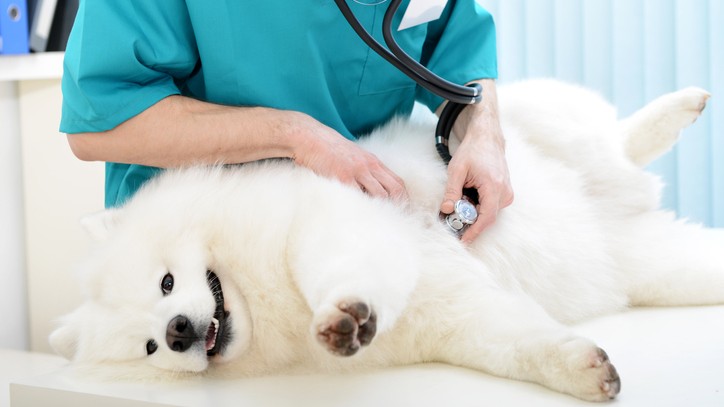How to tell if a dog is pregnant
Wondering how to tell if a dog is pregnant? Our vet explains why it’s harder than you’d think!

Whether you were planning a litter of puppies or your female got out whilst in heat, you might be wondering how to tell if a dog is pregnant. Actually, working out if a dog is pregnant isn’t easy, and accidental surprise litters are fairly common. So, are there pregnancy tests for dogs? We’re going to look at some clues to help you work out if your dog is pregnant, as well as some of the reasons why it can be hard to tell if a dog is carrying babies or not!
- Best puppy food: Wet and dry options for your young pup
- Best puppy toys: Ten options for tackling boredom, teething and anxiety
- Best teething toys for puppies: Calm your pup's natural instincts
Pregnancy … Or false pregnancy ?
Why is it so hard to tell if a dog is pregnant? Well, the reason lies in their hormones. Most people are familiar with a human fertility cycle – several days of menstruation, then a week or so later a fertile window around the time of ovulation. Next is the ‘two week wait’, then, if not pregnant, another menstruation around a month after the first. For humans, we can tell a pregnancy has ‘taken’ within 2-3 weeks of fertilisation, and this is hugely helped by urine tests looking for HCG (human chorionic gonadotropin), which is produced by pregnant women.
But a dog’s cycle is different. Dogs bleed around the same time as they ovulate – when they’re ‘in heat’ or ‘in oestrus’. They then go through a long period of dioestrus, when the uterus grows and the body produces progesterone – even if the dog isn’t pregnant. Dioestrus lasts a couple of months – about the same as a canine pregnancy. In other words, hormonally, a female dog produces the same hormones and goes through the same changes regardless of whether she’s pregnant or not. If she isn’t pregnant, a female will enter anoestrus, and then start the cycle again around 6 months after the first.
But my dog never had a false pregnancy before? What are the signs?
Hormonally, all unneutered female dogs have a false pregnancy or ‘phantom pregnancy’, even if they haven’t been mated and even if they don’t usually show signs. Womb enlargement, breast enlargement, and even milk production happen in some dogs, or in some cycles. They may also have other signs of a false pregnancy such as:
- Abdominal enlargement and weight gain
- Mammary (breast) enlargement
- Milk production
- Not eating
- Carrying dog toys around and ‘mothering’ them
- Behavioural changes including clinginess or aggression
- Vomiting (but be careful as this is a sign of pyometra, a dangerous infection of the womb that may happen at this time of your dog’s cycle)
- Vaginal discharge – also a symptom of pyometra!
So, what are the early signs of pregnancy in dogs?
If you want to work out whether your dog is pregnant in plenty of time to prepare for the puppies, you’ll need to keep an eye out for some of these early signs of pregnancy in dogs. However, it’s important to bear in mind that these signs are very similar to those for false pregnancy, so you won’t get a definitive answer this way!
- Decreased or increased appetite
- Lethargy or decreased energy
- Swollen nipples
- Abdominal enlargement
- Milk production
- Behavioural changes
- Vomiting
Still not sure if it’s a false pregnancy or real pregnancy?
Looking at those two lists, you’ll see it’s very hard to tell just by signs that a dog is pregnant rather than pseudo-pregnant. With the same hormones flying around, it’s not surprising the symptoms are the same. So how else can you tell if a dog is pregnant? The first step is to talk to your vet and give them the dates of your dog’s last season. They’ll then advise which of the following options is best for you – and you may even need all three!
Palpation
In a cooperative dog, a vet may be able to feel the changes in the uterus that occur with pregnancy. This is usually possible from around day 21 to day 35, after which it becomes too difficult to do. It’s a simple, painless procedure completed in a conscious dog, but isn’t always possible due to temperament, body shape, obesity, and other things.
Get the best advice, tips and top tech for your beloved Pets

Relaxin blood test
A blood test for a hormone called relaxin that’s produced from the placenta during pregnancy is another option. This blood test can be done from around day 23. Assuming your dog is cooperative, it’s a simple procedure that can be performed conscious. The results are usually conclusive, but – like a negative urine test for a human – if signs persist should be performed again a week later, in case there wasn’t enough hormone to detect at first.
Ultrasound scan

There’s no NHS for pets. Veterinary care can be eye-wateringly expensive and most pets will need treatment for an illness or injury at some point in their life. It’s difficult to think about your animals being hurt or unwell, but you need to ask yourself: what would you do if you were faced with a vet bill for hundreds or thousands of pounds?
An ultrasound scan is a quick and simple procedure that – in most animals – can be done on a conscious dog. Just like the ultrasound for human pregnancies, the scanner probe uses soundwaves to build a picture of your dog’s insides – and will quickly determine whether the uterus contains foetuses. These ultrasounds can be done from day 25, but are generally best done before day 35.
Whilst in humans you might be used to an ultrasound being able to detect multiple pregnancies, in dogs it’s not possible to count the foetuses during an ultrasound scan. Your vet may be able to say ‘at least five’ but they can’t tell you for sure how many are in there. Ultrasounds may also help to determine a due date, especially in animals when the season went unnoticed.
X-rays
A bit later in pregnancy, from around day 42 onwards, a radiograph (x-ray) is the best way to tell whether a dog is pregnant. Later in pregnancy, an x-ray also has the advantage of allowing you to count the foetuses as well as to estimate their size and therefore the likelihood of them being born naturally. However, x-rays require an animal to stay completely still whilst everyone leaves the room. Whilst sedation is normally an option, it’s not recommended in pregnant dogs, so it can be hard to get a reliable x-ray image in some dogs.
Unlike in humans, there are no reliable ways to tell if your dog is pregnant at home. Instead, you’ll need to visit your vet and undertake some tests to decide if your dog is pregnant or having a false pregnancy. If your dog does turn out to be pregnant, you should discuss the next steps with your vet. For some people, this may be to request a spay to avoid any risk to the mother and prevent an unwanted litter. For others, this may be to do everything recommended to support the pregnancy. Changes in diet, worming regime, medications, and other things may all be necessary, so be prepared to take your vet’s advice to ensure the health of pups and mum.
You might also be interested in learning about fading puppy syndrome if your dog is expecting.
After graduating as a vet from the University of Nottingham in 2016, Dr. Joanna Woodnutt went on to practice companion animal medicine in the Midlands. She quickly developed a love of consulting and helping clients with medical problems such as dermatology, behavior and nutrition - anything that involved helping clients understand their pets better.
Jo started writing about pet health in 2017, realizing that it meant she could help even more pet parents. Since then, she has written for countless online and print publications and is a regular contributor for Edition Dog Magazine. Jo is the director of The Veterinary Content Company, which she founded in 2020. She is also the founder of Petlearnia, a platform that provides pet e-learning courses for pet parents.
Jo now lives in the Channel Islands with her husband Ian and terrier Pixie.

